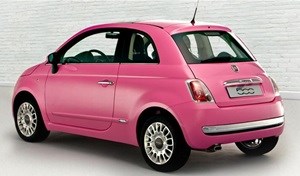The latest data from Lightstone shows that white is still the most preferred colour when it comes to vehicle purchases between women and men.
When looking at colour car preference between 2010 (where white, silver and black were the most popular choices) and 2015 (where white, silver and grey cars are at the top of the list) there isn't much difference. Of all of the white colour cars purchased, approximately 43% of them are owned by females, which is not far off from their male counterparts who own 57%. When it comes to silver colour vehicles, females own about 44% and males own 56%.
Rory Judd, Head of Online Marketing at MiWay insurance, notes that there are a number of factors owing to why lighter colour cars are the better option. "Cars that are lighter in colour are a good buy as they usually have lower premiums than darker colour cars."
White and silver colour paints are standard and should be readily available at all motor dealerships and repair shops, which means the paint won't have to be ordered in to match the colour of more 'unique' colour cars - which drives up premiums.
Lighter or brighter-coloured cars are more visible on the road and are thus less likely to be involved in a crash during daylight hours than vehicles in lower-visibility colours such as black, blue, grey and green. That said, while lighter colours may have lower premiums, it is not the only factor influencing premiums - what really matters is your driving record and the car you drive. Insurance companies will look at the make and model of a car, the accident rate, how protected the car is in a crash and how expensive it is to repair and replace.
Premiums aside, lighter-colour cars also have a bit more practicality associated to them in that they may be a bit more comfortable in our hot climate than darker cars; and scratches on lighter cars are less noticeable than on darker cars, meaning that lighter colours require less maintenance.
Less-is-more
While lighter colour vehicles are great for those looking for a simple "less-is-more" feel or for those who want better insurance premiums, there are still a fair amount of South Africans who prefer more "adventurous" colours when it comes to their vehicles.
According to Lightstone's research into new vehicles purchased, blue cars are in fourth place and red cars are in sixth place of most popular car colours in South Africa.
When looking at the 18,732 red vehicles purchased, females own approximately 53%. Red is quite a bold colour and those who opt for a red vehicle may be looking to express themselves with a splash of colour, as opposed to opting for a "play-it-safe" colour such as white or silver.
A big trend at the moment is women wearing bright and bold red lipstick, which, when asked, most women will note that they feel more confident and empowered with this colour. It is interesting to note that nail polish maker OPI and Ford recently introduced a limited-edition colour, Race Red, to commemorate the Ford Mustang's 50th anniversary, which could set a trend for colourful car purchases in future.

That said, though, where pink car sales peaked in 2013 with 296 pink vehicles sold in the South African market, this has taken a dip in 2015 where only 12 pink vehicles were sold. Kia Picanto's and Fiat 500's make up the two models that are most favourable in a pink colour.
Cars that are a little more "eccentric" in colour are purchased a lot less frequently, which comes down to the fact that these colour vehicles would have higher premiums owing to the paint colour not being easily accessible, as well as increased difficulty when it comes to trade-ins or re-selling of such colour vehicles - where many people may not have a pink colour preference of used vehicles.
Darker and more eccentric colour cars require more maintenance than lighter cars, as scratches are more noticeable and would thus require more frequent paint touch-ups; whereas on white and lighter colour cars, scratches are less noticeable.
Looking at Lightstone's data, it's clear that women have a higher affinity to brightly coloured vehicles, and men steer toward duller colours. Next time you're setting out to buy a vehicle, trends and colours may come and go, but think about what effect the colour of the vehicle will have on your insurance premiums and your pocket in the long run. And if you're a trendsetter at heart, while the cost implications would be a factor in your purchasing decision, there's no doubt you'll opt for something that shows off your personality (and matches your nail polish.)

























